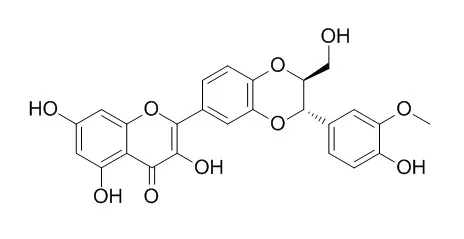| In vitro: |
| ACS Chemical Neuroscience, 09 Jun 2017, 8(8):1767-1778. | | Inhibition of Aβ Amyloid Growth and Toxicity by Silybins: The Crucial Role of Stereochemistry.[Reference: WebLink] | The self-assembling of the amyloid β (Aβ) peptide into neurotoxic aggregates is considered a central event in the pathogenesis of Alzheimer's disease (AD). Based on the "amyloid hypothesis", many efforts have been devoted to designing molecules able to halt disease progression by inhibiting Aβ self-assembly.
METHODS AND RESULTS:
Here, we combine biophysical (ThT assays, TEM and AFM imaging), biochemical (WB and ESI-MS), and computational (all-atom molecular dynamics) techniques to investigate the capacity of four optically pure components of the natural product silymarin (silybin A, silybin B, 2,3-dehydrosilybin A, 2,3-Dehydrosilybin B) to inhibit Aβ aggregation. Despite TEM analysis demonstrated that all the four investigated flavonoids prevent the formation of mature fibrils, ThT assays, WB and AFM investigations showed that only silybin B was able to halt the growth of small-sized protofibrils thus promoting the formation of large, amorphous aggregates. Molecular dynamics (MD) simulations indicated that silybin B interacts mainly with the C-terminal hydrophobic segment 35MVGGVV40 of Aβ40. Consequently to silybin B binding, the peptide conformation remains predominantly unstructured along all the simulations. By contrast, silybin A interacts preferentially with the segments 17LVFF20 and 27NKGAII32 of Aβ40 which shows a high tendency to form bend, turn, and β-sheet conformation in and around these two domains. Both 2,3-dehydrosilybin enantiomers bind preferentially the segment 17LVFF20 but lead to the formation of different small-sized, ThT-positive Aβ aggregates. Finally, in vivo studies in a transgenic Caenorhabditis elegans strain expressing human Aβ indicated that silybin B is the most effective of the four compounds in counteracting Aβ proteotoxicity.
CONCLUSIONS:
This study underscores the pivotal role of stereochemistry in determining the neuroprotective potential of silybins and points to silybin B as a promising lead compound for further development in anti-AD therapeutics. |
|






 Cell. 2018 Jan 11;172(1-2):249-261.e12. doi: 10.1016/j.cell.2017.12.019.IF=36.216(2019)
Cell. 2018 Jan 11;172(1-2):249-261.e12. doi: 10.1016/j.cell.2017.12.019.IF=36.216(2019) Cell Metab. 2020 Mar 3;31(3):534-548.e5. doi: 10.1016/j.cmet.2020.01.002.IF=22.415(2019)
Cell Metab. 2020 Mar 3;31(3):534-548.e5. doi: 10.1016/j.cmet.2020.01.002.IF=22.415(2019) Mol Cell. 2017 Nov 16;68(4):673-685.e6. doi: 10.1016/j.molcel.2017.10.022.IF=14.548(2019)
Mol Cell. 2017 Nov 16;68(4):673-685.e6. doi: 10.1016/j.molcel.2017.10.022.IF=14.548(2019)